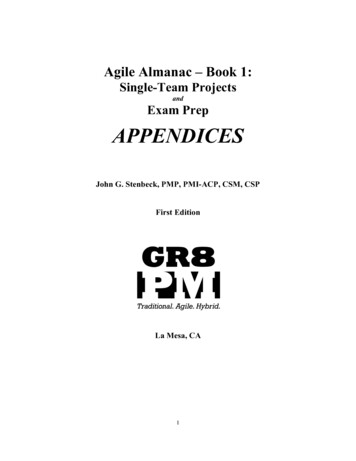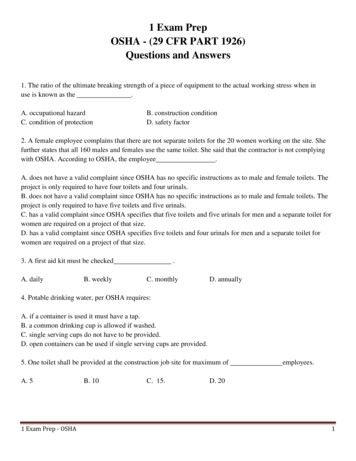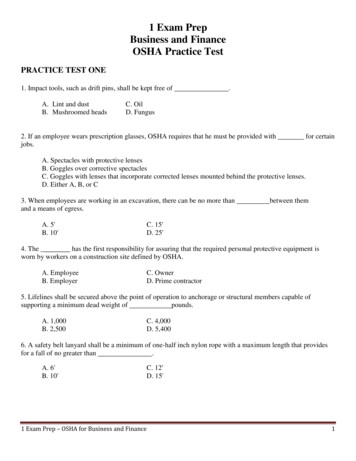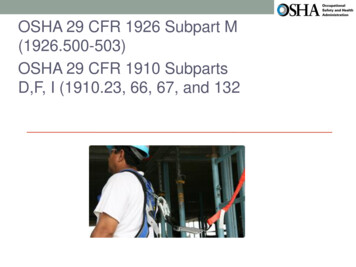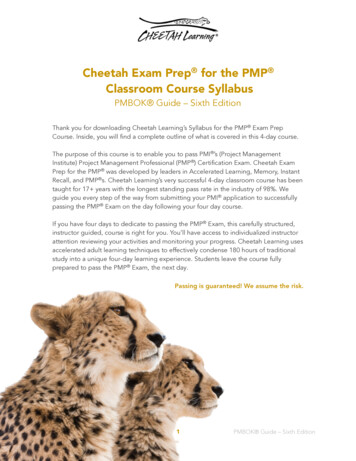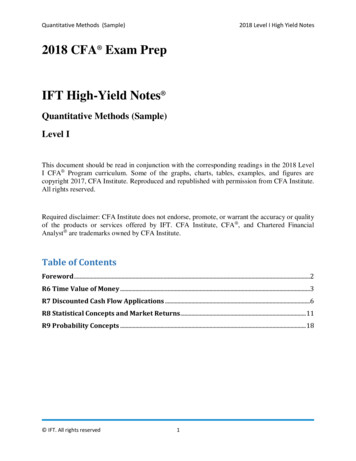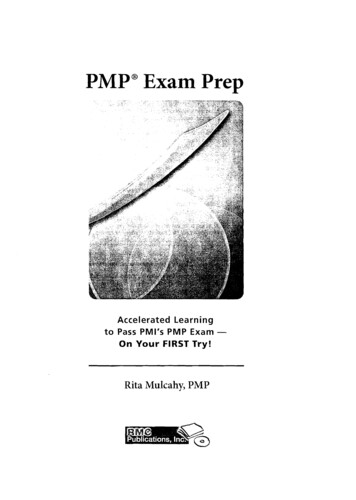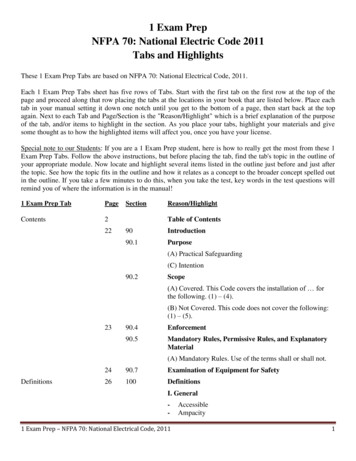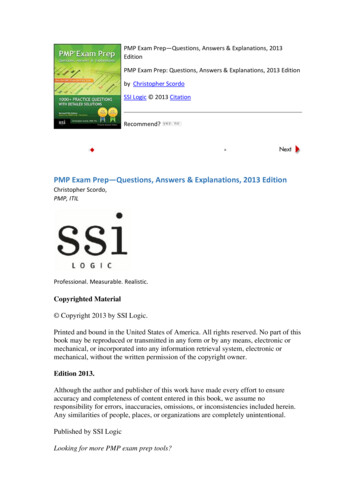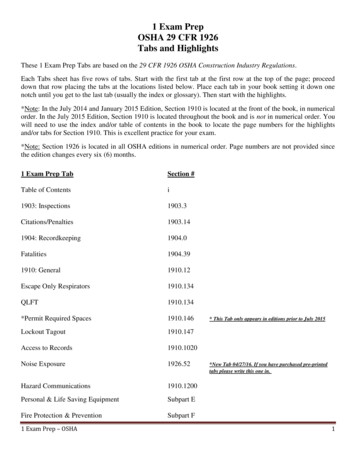
Transcription
1 Exam PrepOSHA 29 CFR 1926Tabs and HighlightsThese 1 Exam Prep Tabs are based on the 29 CFR 1926 OSHA Construction Industry Regulations.Each Tabs sheet has five rows of tabs. Start with the first tab at the first row at the top of the page; proceeddown that row placing the tabs at the locations listed below. Place each tab in your book setting it down onenotch until you get to the last tab (usually the index or glossary). Then start with the highlights.*Note: In the July 2014 and January 2015 Edition, Section 1910 is located at the front of the book, in numericalorder. In the July 2015 Edition, Section 1910 is located throughout the book and is not in numerical order. Youwill need to use the index and/or table of contents in the book to locate the page numbers for the highlightsand/or tabs for Section 1910. This is excellent practice for your exam.*Note: Section 1926 is located in all OSHA editions in numerical order. Page numbers are not provided sincethe edition changes every six (6) months.1 Exam Prep TabSection #Table of Contentsi1903: Inspections1903.3Citations/Penalties1903.141904: Recordkeeping1904.0Fatalities1904.391910: General1910.12Escape Only Respirators1910.134QLFT1910.134*Permit Required Spaces1910.146Lockout Tagout1910.147Access to Records1910.1020Noise Exposure1926.52Hazard Communications1910.1200Personal & Life Saving EquipmentSubpart EFire Protection & PreventionSubpart F1 Exam Prep – OSHA* This Tab only appears in editions prior to July 2015*New Tab 04/27/16. If you have purchased pre-printedtabs please write this one in.1
1 Exam Prep TabSection #Yard Storage1926.151(C)Signs, Signals & BarricadesSubpart GMaterial Handling, Storage Use & DisposalSubpart HTools - Hand & PowerSubpart ICompressed Air1926.302(b)(4)Welding & Cutting“Cracking”Subpart JElectricalSubpart KScaffoldsSubpart LFall ProtectionSubpart MRoof Widths1926.501 (b)(10)Personal Fall Systems1926.502(d)Positioning Device Systems1926.502(e)Sample Fall Protection1926.502(k)Cranes, Derricks & HoistsSubpart NMotor VehiclesSubpart OExcavationsSubpart PSoil ClassificationsAppendix ASloping & BenchingAppendix BDemolitionSubpart TPower & DistributionSubpart VRollover & Overhead ProtectionSubpart WStairways & LaddersSubpart XDivingSubpart Y1 Exam Prep – OSHA*New Tab 04/27/16. If you have purchased pre-printedtabs please write this one in.2
1 Exam Prep TabSection #Toxic & Hazardous SubstancesSubpart ZIndexIndex***This concludes the tabs for this document. Please continue with the highlights on the following page.***Section #Highlight1903Inspections, Citations, and Proposed Penalties1904.1Recording and Reporting Occupational Injuries and Illnesses1904.1(a)(1)Basic Requirement: If your company had ten (10) or fewer employees at all timesduring the last calendar year, you do not need to keep OSHA illness and injury records.1904.39Reporting fatalities and multiple hospitalization incidents to OSHA1910General Industry Standards1910.134(b)Escape only respirators means a respirator intended to be used only for emergency exist.1910.134(f)(6)QLFT may only be used to fit test negative pressure air purifying respirators that mustachieve a fit factor of 100 or less.1910.146Permit required confined spaces1910.147The control of hazardous energy (lockout/tagout)1910.1020Access to employee exposure and medical records1910.1020(e)(1)(i)Whenever an employee requests access to records (15 days)1910.1200Hazard CommunicationsSubpart AGeneral1926.1Purpose and scope1926.3Right of Entry, right to accompanySubpart BGeneral Interpretations1926.12Reconciles various documents and Acts1926.13Interpretation of Statutory Terms1 Exam Prep – OSHA3
Section #Highlight1926.15(b)Federal Contracts over 10,000: Nothing can be bought from violating manufacturer's; noservices from violating contractorsSubpart CGeneral Safety and Health provisions1926.20 (a)(1)General safety and health provisions. No one works in unsafe environment1926.21(b)(2) Employer responsibility: instruct each employee in the recognition andavoidance of unsafe conditions1926.21-31First aid, fire, housekeeping, illumination, sanitation, personal protective equipment,these are all general areas of employer responsibility. Specific details are not elaboratedin the remainder of 19261926.32(d)Definition of an authorized person1926.32(m)Definition of a qualified person1926.32(j)Definition of an employeeSubpart DOccupational Health and Environmental Controls – minimum site conditions1926.50First Aid Kits (Non-Mandatory)1926.51Sanitation. Potable water available. See Table D-1 for number of employees andminimum # of facilities1926.52Occupational noise exposure. Table D-2 Permissible noise exposures. The info from thetable is used to complete the formula under it. If after the calculation is done, the answerexceeds 1 (unity) it means that the cumulative effect of long term exposure equals tolower levels of noise or exceeds the limit of exposure and therefore has the effect ofinjury.1926.55Vapors, fumes, dusts, and mists. Appendix A-1970 American Conference ofGovernmental Hygienists’ Threshold Limit Values of Airborne Contaminants1926.56Illumination: Table D-3 Minimum Illumination Intensities in Foot Candles1926.57Ventilation. This section covers grinding or dust and particle producing activities, suchas abrasive blasting grinding, polishing equipment.1926.60Methylenedianiline. Practices and procedures for Methylenedianiline.1926.62Lead. References Appendix A-D; Begins section on lead, Lead paint reduction,protection esp. PEL 50 micrograms per cubic meter of air.1926.62(f)Respiratory Protection1 Exam Prep – OSHA4
Section #Highlight1926.62(j)(2)Biological monitoring1926.64Process safety management of highly hazardous chemicals.Subpart EPersonal & Life Saving Equipment1926.95Criteria for personal protective equipment. Section starts identifying and prescribinghead, hearing, eye and face protection measures. Shall be provided; employer responsiblethat equipment is safe design and use head protection whenever necessary1926.100Head Protection1926.102Eye and Face Protection1926.104Safety belts, lifelines, and lanyards. Safety belts, minimum 5,400 dead weight, 1/2 inchthick nylon, hardware cadmium plated type 1 class b plating, tensile loading 4,000 lbs1926.105Safety Nets. Safety nets, needed over 25', 6" x 6" mesh, 17500 foot points minimumresistance; edge ropes 50001926.106Working over or near water. Over water: Ring buoys 90 feet line, 200 max distance.Subpart FFire Protection and Prevention1926.150Fire protection. Table F-1 Fire Extinguishers Data1926.151Fire prevention1926.151(C)Open Yard Storage1926.152Flammable liquids1926.153Liquefied Petroleum Gas (LP-Gas). Includes handling and storage as well as container.Specifications, Table F-3 & F-31 Storage of LP-gas.1926.154Table F-4 minimum clearance for heating equipment.Subpart GSigns, Signals and Barricades1926.200Accident prevention signs and tags. Accident prevention, danger and caution defined.Specific coloring; exit, safety instruction, directional traffic signs defined, accidentprevention tags demonstratedSubpart HMaterial Handling, Storage Use & Disposal1926.250Requirements for storage1 Exam Prep – OSHA5
Section #Highlight1926.250(b)Material storage. (1) “Material stored inside buildings under construction shall not beplaced within 6 feet of any hoist way or inside floor openings ”(4) “Bagged materialsshall be stacked by stepping back the layers and cross keying the bags at least every 10bags high.”(6) “Brick stacks not more than 7' in height. When a loose brick reaches aheight of 4', it shall be tapered back 2" per ft. the above 4' level.” (7) When masonryblocks are stacked higher than 6', the stack shall be tapered back ½ block per tier abovethe 6’ level.” (8) Lumber.1926.251Rigging equipment and material handling.1926.251(c)(4)(iv) Wire rope shall not be used if any length of eight diameters, 10% strands broken(13) Minimum sling lengths 10 times component rope diameter (14) Safe operatingtemperatures1926.251(d)Natural ropes and synthetic fiber. (2)(i) In manila rope, eye splices shall contain at leastthree full tucks. (2)(iii) strand end tails various minimums (6) Removal from serviceTables H-1 through H-2.Series of tables for capacities for various slings1926.252Disposal of Waste MaterialsSubpart ITools -Hand & Power1926.300General Requirements. Various rules about specific tools and machines.1926.300(b)(4)(iv).“The following are some machines which usually require point of operation guarding:(Note [a]-[i]).”1926.300(d)Switches1926.301Hand Tools. Various rules of operation for powerhand tools1926.302Power-operated Hand Tools1926.302(b)(4)“Compressed air should not be used for cleaning purposes except where reduced to lessthan 30 psi and then only with effective chip guarding and personal protective equipmentwhich meets the requirements the requirements of subpart E of this part ”1926.303Abrasive wheels and tools1926.303(b)(1)Guarding. Grinding machines shall be equipped with safety guards.1926.304Woodworking Tools1926.305Jacks – lever and ratchet, screw, and hydraulic. Blocking required for firm foundationSubpart JWelding & Cutting1 Exam Prep – OSHA6
Section #Highlight1926.350Gas welding and cutting1926.350(a)Transporting, moving, and storing compressed gas cylinders.1926.350(a)(10)Oxygen cylinders in storage shall be separated from fuel-gas cylinders having a fireresistance rating of at least one-half hour.1926.350(d)Use of Fuel Gas. The employer shall thoroughly instruct employees in the safe use offuel gas, as follows:1926.350(d)(1)Before a regulator to a cylinder valve is connected This action is general termed“cracking” and is intended to clear the valve of dust or dirt that might otherwise enter theregulator.)1926.351Arc Welding and Cutting1926.351(d)Operating Instructions. Employers shall instruct employees in the safe means of arcwelding and cutting as follows:1926.351(d)(1)When electrode holders are left unattended with employees or conducting objects.1926.354Welding, cutting, and heating in way of preservative coatings. (a) “Before weldingcutting or heating is commenced on any surface covered by a preservative coating whoseflammability is unknown, a test shall be made by a competent person to determine itsflammability.”Subpart KElectrical1926.400Installation Safety Requirements Introduction1926.403General Requirements: Tables K-1 Working Clearances, K-2: Minimum Depth ofClear Working Space, K-3 Elevation of Unguarded Energized Parts1926.404Wiring design and protection.1926.404(b)Branch Circuits1926.404(b)(1)Ground-fault protection1926.404(b)(1)(ii)Ground-fault circuit interrupters. All 120-volt, single-phase, 15- and 20-amperereceptacle outlets need not be protected with ground-fault circuit interrupters.[C] Each chord set, attachment cap, plug and receptacle . Equipment fund damaged ordefective shall not be used until repaired.[D] The following tests shall be performed on all cord sets [1] – [2].1926.404(b)(2)1 Exam Prep – OSHATable K-4: Receptacle Ratings for Various Size Circuits7
Section #Highlight1926.405Wiring Methods, Components, and Equipment for General Use1926.407Hazardous locations. Section deals with classification of locations from Class I – III1926.408Special SystemsSubpart LScaffolds1926.450Scope, application, and definitions applicable to this subpart.1926.450(b)Definitions1926.451General Requirements1926.451(a)Capacity. (1) scaffold component shall be capable of supporting, without failure, its ownweight and at least support 4 times the maximum intended load. (2) Direct connections toroofs and floors, and counterweights at least 4 times the tipping moment.(3) Eachsuspension rope at least 6 times the maximum intended load.(4) Each suspension rope 6 times intended load or 2 (minimum) times the stall load of the hoist, whichever isgreater. (5) Stall load not exceed 3 times rated load (6) Scaffolds shall be designed by aqualified person Non-mandatory Appendix A to this subpart contains examples ofcriteria that will enable the employer to comply with paragraph (a) of this section.1926.451(b)Scaffold platform construction. (1)Each platform on all working levels of scaffoldsshall be fully planked or decked between the front uprights and guardrail supports asfollows: (i) Each platform unit uprights is no more than 1 inch wide (ii) Where theemployer makes demonstration .remaining open space between the platform and theuprights shall not exceed 9 1/2 inches (2) Except provided in paragraphs . at least 18inches wide (i) Each ladder jack scaffold. at least 12 inches wide (ii) Where scaffoldsmust be used 18 inches wide personal fall arrest systems. (3) Except as provided.the front edge of all platforms shall not be more than 14" from the face of the work of this section to protect an employee from falling. (i) The maximum distance from theface for outrigger scaffolds shall be 3 inches. (ii) The maximum distance from the facefor plastering and lathing operations shall be 18 inches. (4) Each end of aplatform.extend over the centerline of its support at least 6 inches. (5)(i) Each end of aplatform 10 feet or less in length shall not extend over its support more than 12 inches or has guardrails which block employee access. (ii) Each platform greater than 10 feet inlength shall not extend more than 18 inches or has guardrails which block employeeaccess to cantilevered ends.1926.451(c)Criteria for supported scaffolds. (1) “Supported scaffolds with height to base widthratio of more than four to one (4:1) shall be restrained ”1926.451(d)Criteria for Suspension Scaffolds1 Exam Prep – OSHA8
Section #Highlight1926.451(e)Access. This paragraph applies to . (1) “When scaffold platforms are more than 2 feetabove or below a point of access, portable ladders, hook-on ladders, attachable ladders,stair towers, stairway-type ladders, ramps, walkways, integral prefabricated scaffoldaccess, or direct access
1 Exam Prep – OSHA 1 1 Exam Prep OSHA 29 CFR 1926 Tabs and Highlights These 1 Exam Prep Tabs are based on the 29 CFR 1926 OSHA Construction Industry Regulations. Each Tabs sheet has five rows of tabs. Start with the first tab at the first row at the top of the page; proceed down that row placing the tabs at the locations listed below. Place each tab in your book setting it down one notch .File Size: 584KBPage Count: 17
